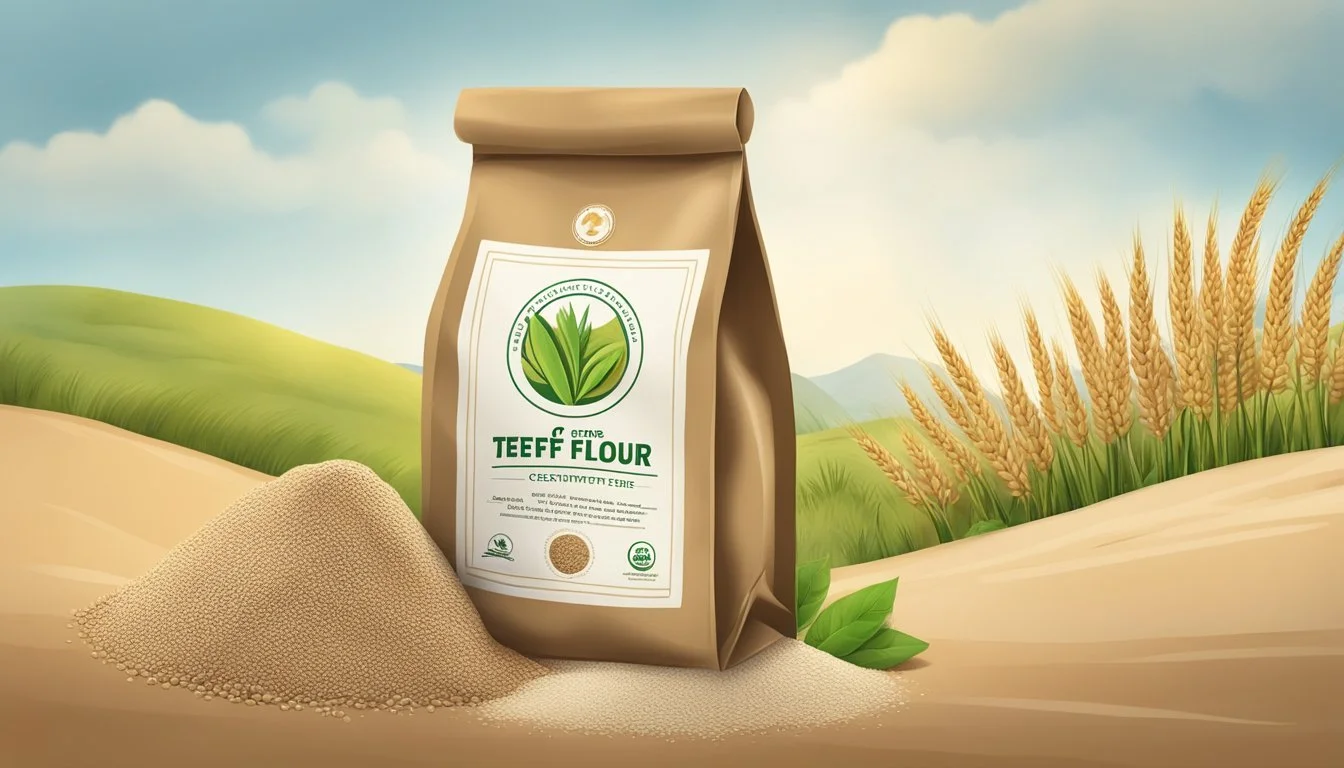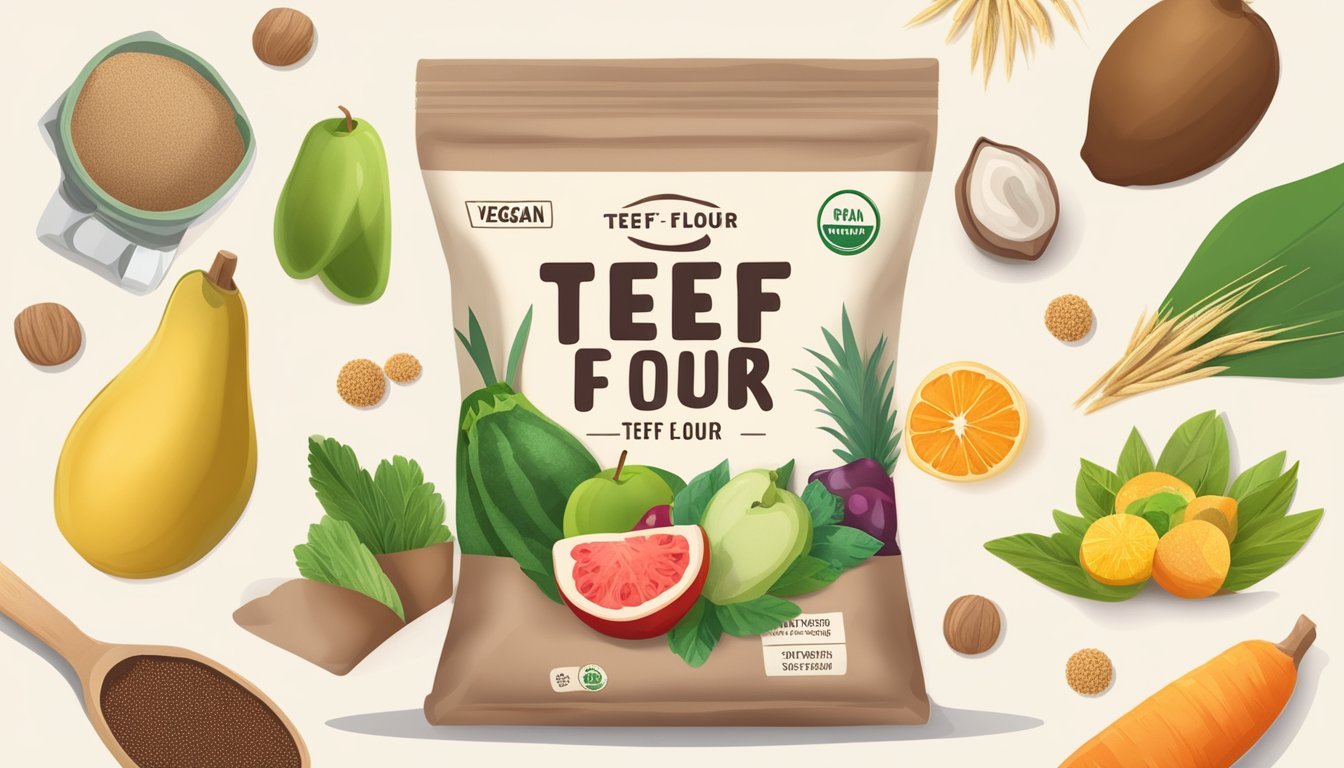Is Teff Flour Vegan?
Exploring Its Plant-Based Credentials
Teff flour is a gluten-free powerhouse revered for its versatility and nutritional profile, which has positioned it as a staple in the dietary repertoire of vegans and those with gluten sensitivities alike. Harvested from the ancient grain teff, which has been a cornerstone in Ethiopian cuisine for centuries, the flour made from this grain is inherently plant-based, thereby making it vegan by nature. Rich in protein, fiber, and essential minerals such as calcium and iron, it offers a substantial nutritional contribution to vegan diets, which often require careful planning to ensure all nutritional needs are met.
The use of teff flour spans a variety of culinary applications, from the traditional Ethiopian sourdough flatbread known as injera to an array of baked goods. Due to its fine texture and nutty flavor, it is highly adaptable, allowing for exploration in creating vegan recipes, including bread, pancakes, and porridge. When utilizing teff flour in vegan cooking, its compatibility with other plant-based ingredients adds to its appeal, ensuring that those following a vegan lifestyle can enjoy a diverse and nutritionally complete diet.
It is clear that teff flour aligns seamlessly with vegan principles, offering a cruelty-free ingredient option that does not compromise on nutritional value. Its growing popularity underscores its suitability not only as a gluten-free alternative but also as a core component of modern vegan cuisine. With teff flour, vegans can enjoy a broad spectrum of flavorful foods without transgressing their ethical and dietary boundaries.
Understanding Teff Flour
Teff flour is derived from teff grain, an ancient cereal native to Ethiopia and Eritrea. Recognized for its versatility and nutritional benefits, it's a key ingredient in a range of gluten-free and vegan recipes.
Origin and History
Teff grain has been a staple in Ethiopian and Eritrean cuisines for centuries. As the smallest grain in the world, it is known for its resilience in various climatic conditions, making it a reliable crop in its native regions. Its use in traditional dishes stretches back over millennia, securing its place as an ancient and cherished grain.
Nutritional Profile
Teff is lauded for its dense nutritional content. It is rich in minerals, including iron, calcium, magnesium, and zinc. Its flour is also an excellent source of protein, fiber, and essential vitamins. Here's a simplified nutritional profile of teff flour:
Protein: Helps in muscle development and repair
Fiber: Benefits digestive health
Iron: Essential for blood health
Calcium: Important for bone strength
Magnesium: Supports muscle and nerve function
Zinc: Crucial for immune system performance
Culinary Uses
As an ingredient, teff flour is celebrated for its versatility in the kitchen. It can be used to prepare injera, a traditional fermented flatbread that is a cornerstone of Ethiopian and Eritrean cuisine. Beyond injera, teff flour is used in a variety of gluten-free baked goods such as bread, pancakes, and porridge. Its subtle nutty flavor complements both sweet and savory dishes, and its fine texture makes it an excellent thickening agent in sauces and stews.
Teff Flour in a Vegan Diet
Teff flour emerges as an excellent addition to the vegan pantry, particularly appealing to those seeking a nutritious and gluten-free grain alternative for their culinary creations.
Vegan Baking Alternatives
Teff flour provides a gluten-free and nutritious alternative for vegan baking. It can readily replace traditional flour in recipes for bread, pancakes, cookies, and muffins. Dairy and egg substitutes in vegan baking often include apple cider vinegar, coconut oil, and dairy-free milk options, which pair well with the nutty flavor of teff flour. Its fine texture allows bakers to create rich and satisfying goods without the use of traditional baking ingredients like butter.
Comparing Teff to Other Grains
When comparing teff to other gluten-free grains such as quinoa, rice, sorghum, or buckwheat flour, teff stands out due to its small size and high nutrient density. Here's how teff compares in terms of protein content:
Gluten-Free Grain Approximate Protein Content per 1 cup (cooked) Teff 10 grams Quinoa 8 grams Brown Rice 5 grams Sorghum 22 grams (1 cup, uncooked) Buckwheat 6 grams
Teff's high protein content makes it particularly valuable in a vegan diet, where strategic planning is often necessary to meet protein intake requirements.
Health Benefits for Vegans
Teff flour is not only a gluten-free flour alternative but also a highly nutritious option that provides various nutritional benefits to vegans. It is rich in calcium, iron, and fiber, making it a strong ally in plant-based diets. The high fiber content aids digestion, while its iron content helps prevent anemia— a common concern in vegan diets. Teff also contributes to a higher protein intake, important for muscle repair and growth in vegan populations who forego animal proteins.
Gluten-Free Aspects of Teff Flour
Teff flour is a high-fiber, nutritious grain that has become a cornerstone in gluten-free diets, particularly for those with celiac disease due to its lack of gluten. Now let's examine how it fits into a gluten-free lifestyle, notably within the realms of baking and specific recipes.
Teff Flour in Gluten-Free Baking
Teff flour is renowned for its versatility in gluten-free baking. It can replace wheat flour entirely or be combined with other gluten-free flours to create a balanced blend. For gluten-free bread, using teff flour adds a unique, earthy flavor and enhances the nutritional value of the bread. Baking powder is often incorporated to give rise to breads, muffins, and cakes, compensating for the absence of gluten that typically provides structure and elasticity. Due to its fine texture, teff flour can also be successfully used to make tender and light baked goods like cookies and brownies.
Key baking considerations for teff flour:
Replace wheat flour wholly or in part for various recipes.
Can be mixed with starches for improved texture.
Requires baking powder to aid in leavening baked goods.
Gluten-Free Recipes with Teff
Teff flour shines in a range of gluten-free recipes, offering a nutritious and delicious alternative for baked goods.
Examples of gluten-free recipes with teff:
Bread: Gluten-free teff bread typically includes psyllium husk or xanthan gum to improve the texture.
Pancakes: Teff pancakes can be enriched with fruits, nuts, or a homemade syrup for added sweetness.
Cookies: Chocolate chip cookies made with teff flour provide a satisfying, chewy texture.
Crepes: To create teff crepes, blend the teff batter until smooth and cook on a hot skillet for a gluten-free spin on this French classic.
Each recipe mentioned maximizes teff flour's potential to provide palatable gluten-free options that don't compromise on taste or quality.
Teff Flour's Versatility in Recipes
Teff flour is esteemed for its adaptability, paving the way for various culinary creations from sweet desserts to hearty savory meals. It's a gluten-free alternative that embraces diverse flavors and integrates seamlessly into numerous global cuisines.
Sweet and Savory Applications
Derived from the ancient grain teff, teff flour is a staple ingredient capable of conjuring both sweet and savory dishes. It possesses a subtle nuttiness that enhances cookies, cakes, and breads, and can be sweetened with natural ingredients like maple syrup, cinnamon, or vanilla extract. For savory settings, it contributes a pleasing, slightly earthy base to stews and flatbreads, and pairs remarkably well with bold spices like ginger.
Sweet Recipes
Desserts: Chocolate teff flour brownies enhanced with cinnamon or vanilla extract for a warm depth of flavor.
Breakfast: Teff porridge sweetened with maple syrup or mixed with aromatic spices.
Savory Recipes
Main Courses: Teff flour as a thickening agent in stews, imparting both substance and a pleasing texture.
Baked Goods: Adapted for pizza dough or flatbread, providing a hearty base for toppings.
International and Fusion Dishes
Teff flour's versatility shines brightly in the global kitchen. It's the foundation of injera, the traditional Ethiopian sourdough flatbread, which is a canvas for a variety of Ethiopian meals. Its adaptability also makes it suitable for fusion dishes—reinventing conventional recipes by introducing teff flour for a new twist on familiar flavors.
Ethiopian Cuisine
Injera: Teff flour's quintessential use in creating the spongy, sour flatbread, integral to Ethiopian dining.
Stews: Teff flour contributes to the rich texture in Ethiopian stews, accompanying the injera.
Fusion Dishes
Pizzelles: Imaginative cooks might incorporate teff flour in making these traditional Italian waffle cookies, pairing it with chocolate or cinnamon for a unique take.
Flatbread Pizzas: A modern twist, using the teff flour base for pizza dough, which introduces a new textural experience to a classic dish.
Through its wide-ranging applications, teff flour demonstrates its versatility, allowing for the creation of diverse dishes that cater to sweet and savory palates alike. From traditional Ethiopian meals to contemporary international fusions, teff flour is a dynamic ingredient fit for any culinary challenge.
Purchasing and Storing Teff Flour
When buying teff flour, consumers have multiple choices, ranging from white to brown teff and pre-packaged brands like Bob's Red Mill and Maskal Teff. Proper storage is crucial to maintain freshness and extend shelf life.
Where to Buy Teff Flour
Teff flour is available at a variety of outlets. Consumers can purchase it at supermarkets, health food stores, and online marketplaces. For those who prefer specific varieties such as brown teff or white teff, specialty brands like Bob's Red Mill and Maskal Teff, often found in states like Idaho which champions whole grain flour, might offer more options. When shopping, buyers should consider the type of teff flour they desire, whether it's whole grain for a nuttier flavor or a milder version for blending with other flours.
Supermarkets: Often carry basic teff flour options near the baking or gluten-free section.
Health food stores: Typically offer a broader range, including organic and non-GMO varieties of teff flour.
Online Retailers: Provide convenience and can be a source of bulk purchases or specialty types, such as Maskal or Bob's Red Mill.
Storage and Shelf Life
Teff flour's longevity is influenced by how it's stored. The typical shelf life can range from 1 to 2 years, depending on exposure to elements like air and moisture. To ensure the flour remains of optimal quality, the following storage methods should be employed:
Airtight Container: Store teff flour in an airtight container to keep out moisture and other contaminants.
Cool, Dry Place: A pantry away from direct sunlight or a cupboard at room temperature is suitable.
Refrigerator/Freezer: For prolonged storage, teff flour can be frozen. Prior to using it from the freezer, bring it to room temperature using warm water to avoid any clumping when mixed with liquids.
Storage Method Description Airtight Container Essential for protecting against moisture and prolonging shelf life. Cool, Dry Place Shields the flour from temperature fluctuations and light exposure. Refrigerator/Freezer An option for extending shelf life beyond the typical pantry storage.
Remember that even within its best-by dates, one should assess the flour’s smell and texture before use, as these are good indicators of its current quality.
Preparing Teff Flour Based Dishes
Teff flour offers a nutrient-dense and gluten-free alternative for various recipes ranging from bread to cakes. Its versatility in both sweet and savory dishes makes it highly suitable for vegans and those with gluten intolerance.
Essential Equipment for Teff Recipes
Blender: An effective blender is critical for recipes requiring a smooth integration of teff flour, especially for batters.
Spatula: A sturdy spatula aids in folding teff flour into mixtures and scraping bowls clean.
Baking Pans: Use the appropriate size baking pans lined with parchment paper to prevent sticking and ensure easy removal.
Measuring Tools: Accurate measuring cups and spoons are essential for the precise ratios needed in teff recipes.
Mixing Bowls: Large mixing bowls are necessary for combining teff flour with other ingredients evenly.
Tips for Cooking and Baking
Hydration: Teff flour absorbs more liquid than other flours. Begin with a lesser amount of liquid and adjust as needed.
Sweeteners: Incorporate vegan-friendly sweeteners such as coconut sugar to complement teff's nutty flavor.
Fat: Utilize fats like olive oil for moistness in cakes and muffins or to ensure a crispy texture in cookies.
Leavening Agents: For lift and airiness in baked goods, ensure the use of baking powder or baking soda is correctly measured.
Spices: Ground cinnamon pairs well with teff's earthy tones, enhancing the flavor profile of your dishes.
Vinegar: A dash of vinegar can be added to baking recipes with teff flour to react with leavening agents, promoting rise.
Salt: Sea salt can be used to balance and elevate the flavors in teff-based dishes.
Nutritional and Dietetic Considerations
Teff flour, a staple of Ethiopian cuisine, has gained popularity worldwide primarily for its nutritional benefits and versatility in various diets. As an inherently vegan ingredient, teff flour is a nutrient-packed choice for those following a plant-based diet, and its lack of gluten makes it suitable for individuals with celiac disease or gluten intolerance.
Caloric and Macronutrient Content
Teff flour is relatively high in calories, with 100 grams providing about 366 calories. However, it is also nutrient-dense, offering a balanced profile of macronutrients vital for a healthy vegan diet.
Protein: It contains approximately 12.2 grams of protein per 100 grams, a significant amount for a grain, contributing to its categorization as a superfood.
Carbs: Teff flour consists mainly of carbohydrates, with around 70.7 grams per 100 grams, providing the energy necessary for daily activities.
Fiber: High in dietary fiber, it has 12.2 grams per 100 grams which aids in digestion and satiety. The fiber content is beneficial for blood sugar management as it ensures a slow release of energy.
Fat: The flour has a low-fat content at about 3.7 grams, with no significant amount of saturated fat, aligning with heart-healthy dietary guidelines.
Other nutrients in teff flour, such as calcium and magnesium, contribute to the overall nutritional density, making it an excellent addition to a plant-based diet.
Teff in Special Diets
Due to its composition, teff flour is an excellent addition to various special diets:
Vegan Diet: As a plant-based product, teff flour fits seamlessly into a vegan diet, providing essential amino acids often less prevalent in plant foods.
Gluten-Free Diet: For those with celiac disease or gluten sensitivity, it serves as an alternative to wheat flour, allowing the creation of gluten-free bread, pancakes, and other baked goods without compromising on nutrition or flavor.
Plant-Based Nutrition: Teff's rich nutrient profile supports the high nutritional demands of a plant-based lifestyle, particularly for iron and protein.
Other considerations for incorporating teff into special diets include its low natural sugar content and absence of added salt, making it a wholesome choice for maintaining stable blood sugar levels and managing sodium intake.





